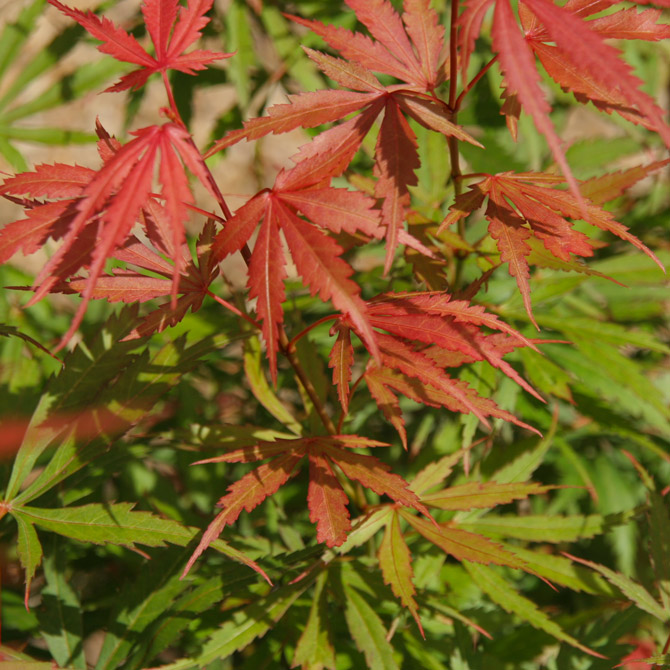Acer palm. ‘Jerre Schwartz’
£195.00
Description
Quick Facts
Common Name: Japanese Maple ‘Jerre Schwartz’
Botanical Name: Acer palmatum ‘Jerre Schwartz’
Family: Sapindaceae Origin: Japan (cultivar)
Foliage: Deciduous, coral-pink spring growth maturing to chartreuse-gold, brilliant autumn colour
Mature Height: 2–3 metres
Mature Spread: 1.5–2 metres
Growth Rate: Slow to moderate Aspect: Partial shade; sheltered position preferred Soil Type: Moist, well-drained, slightly acidic to neutral soil
Hardiness: Hardy in most UK and Irish gardens; benefits from shelter from harsh winds and late frosts
Uses: Specimen tree, container planting, Japanese garden, mixed border, courtyard garden, woodland edge
Description
Acer palmatum ‘Jerre Schwartz’ is a jewel among Japanese maples, prized for its exceptional foliage colour and compact, graceful habit. This cultivar is particularly valued for its spring display, when new leaves emerge in shades of coral-pink with deep crimson margins—a breathtaking combination that seems almost too vivid to be real. As the season progresses, the foliage transitions to soft chartreuse with golden undertones, creating a gentle glow in shaded areas of the garden.
The leaves are finely dissected with five to seven lobes, each delicately pointed and arranged in an elegant, layered pattern along slender branches. This fine texture adds movement and lightness to the garden, with leaves rustling gently in the breeze. In autumn, ‘Jerre Schwartz’ delivers a final crescendo of colour, with foliage turning brilliant shades of orange, red, and amber before falling to reveal the tree’s attractive branching structure.
This is a slow-growing, compact maple, making it ideal for smaller gardens, courtyard spaces, or container cultivation. Its modest size and refined habit allow it to fit comfortably into mixed borders or serve as a stunning focal point in a Japanese-inspired garden. ‘Jerre Schwartz’ thrives in the mild, moist climate of Ireland and the UK, where it benefits from shelter, dappled shade, and protection from harsh winds that can scorch the delicate foliage.
Caragh Garden Notebook: Care & Cultivation
Planting Plant Acer palmatum ‘Jerre Schwartz’ in spring or autumn when the soil is workable and temperatures are mild. Choose a sheltered position with partial shade—morning sun is ideal, but avoid hot afternoon sun which can scorch the delicate leaves. Protection from cold, drying winds and late spring frosts is essential to preserve the tender new growth.
The soil should be moist, well-drained, and slightly acidic to neutral (pH 5.5–7.0). Japanese maples dislike heavy clay or waterlogged conditions, so improve drainage by incorporating plenty of organic matter such as well-rotted compost or leaf mould. Dig a planting hole twice the width of the root ball but no deeper, ensuring the top of the root ball sits level with the surrounding soil. Backfill gently, firm the soil, water thoroughly, and apply a 5–7cm mulch of bark chips or leaf mould around the base, keeping it clear of the stem.
Watering Water regularly during the first two growing seasons to establish a strong root system. Once established, ‘Jerre Schwartz’ is reasonably drought-tolerant but performs best with consistent moisture, especially during dry spells in spring and summer. Container-grown specimens require more frequent watering. Avoid overhead watering in full sun, as water droplets can magnify sunlight and scorch the leaves.
Feeding Feed in early spring (March) with a slow-release balanced fertiliser or a feed formulated for acid-loving plants. Avoid high-nitrogen fertilisers, which can encourage soft, leggy growth prone to wind damage. A light application of well-rotted compost or leaf mould as a top dressing in spring will provide gentle, sustained nutrition.
Pruning Japanese maples require minimal pruning and are best left to develop their natural shape. If necessary, prune in late summer or early autumn (August to September) when sap flow is reduced, avoiding late winter and early spring when maples “bleed” sap profusely. Remove any dead, damaged, or crossing branches, and lightly thin crowded growth to improve air circulation. Avoid heavy pruning, as this can spoil the tree’s elegant form.
Mulching Refresh the mulch layer each spring to retain moisture, suppress weeds, and protect shallow roots from temperature extremes. Keep mulch away from the trunk to prevent rot and discourage pests.
Pests & Diseases Generally trouble-free. Occasionally affected by aphids in spring; treat with a gentle spray of water or horticultural soap if necessary. Watch for signs of verticillium wilt (wilting branches, discolouration)—remove affected branches promptly and improve soil drainage. Leaf scorch can occur in hot, dry, or windy conditions; ensure adequate watering and provide shelter.
Companion Plants Pair ‘Jerre Schwartz’ with shade-loving perennials and shrubs that complement its refined habit and seasonal colour. Consider planting alongside Hosta, Astilbe, Hakonechloa (Japanese forest grass), Epimedium, Ferns such as Dryopteris or Athyrium, Helleborus, and spring bulbs like Erythronium or Anemone nemorosa. Underplant with low-growing groundcovers such as Ajuga or Vinca minor for year-round interest. Combine with other Japanese maples, Pieris, Rhododendron, or Camellia for a harmonious woodland or Japanese garden scheme.
Design Suggestions Use Acer palmatum ‘Jerre Schwartz’ as a specimen tree in a prominent position where its seasonal colour changes can be admired up close. Plant near a seating area, courtyard, or entrance where the intricate foliage and branching structure can be appreciated. Grow in a large container on a patio or terrace for a stunning focal point, or incorporate into a mixed border with shade-loving perennials and shrubs. Ideal for Japanese-inspired gardens, woodland edges, or as an understory tree beneath taller specimens. Its compact size and slow growth make it perfect for smaller gardens where space is at a premium.





